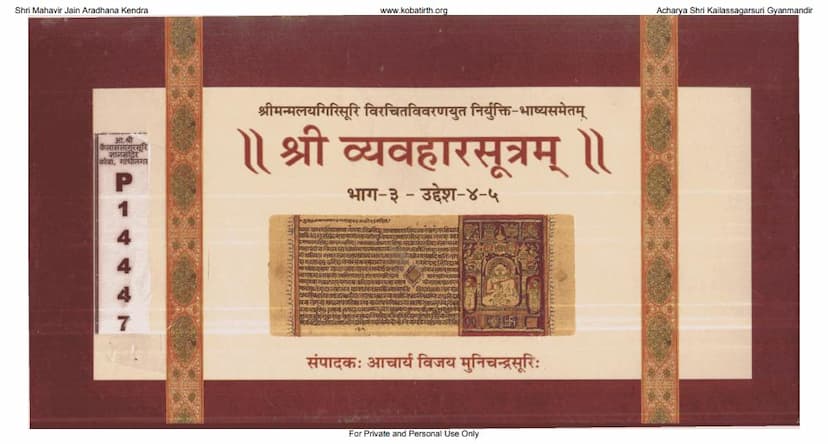Vyavahar Sutram Part 03
Added to library: September 2, 2025

Summary
Here's a comprehensive summary of the provided Jain text, "Vyavahar Sutram Part 03," authored by Munichandrasuri and published by Omkarsuri Gyanmandir Surat, focusing on the content within the provided pages:
Book Title: Vyavahar Sutram Part 03 Author: Munichandrasuri Publisher: Omkarsuri Gyanmandir Surat
Overall Scope:
This volume, Part 3 of the Vyavahar Sutram, covers Chapters (Uddesh) 4 and 5. The text is a commentary on the foundational Jain scripture, Vyavahar Sutram, which deals with the rules and regulations for the conduct of Jain monks and nuns. This specific volume, like others in the series, includes the original Sutras, the Niryukti-Bhashya (a commentary on the Niryukti, which is an explanation of the Sutras), and the commentary by Acharya Malayagiri Suri. The editor is Acharya Vijay Munichandrasuri, assisted by Muni Divyaratnavijay.
Key Themes and Content (Uddesh 4 & 5):
Based on the detailed table of contents (विषयानुक्रमः) provided across pages 10-20, the content of Uddesh 4 and 5 of this volume focuses on intricate details of monastic conduct, particularly concerning:
Uddesh 4: Focus on Monastic Community and Conduct Rules
This chapter delves into various aspects of monastic life, including:
- Monastic Travel (Vihar): Regulations on the number of monks (monks and nuns) who can travel together during different seasons (like Rutubaddha kale - rainy season/monsoon and hemanta-greeshma - winter/summer). This includes discussions on minimum and maximum numbers allowed for specific situations and the penalties (prayaschitta) for violating these rules.
- Dwelling Places (Vasati): Rules regarding occupied and unoccupied dwelling places during the monastic retreat (Varshavas or Chaturmas). This covers the qualities of suitable locations for the retreat, the procedures for maintaining dwellings, and the consequences of leaving them empty.
- Disciplinary Actions and Penances: Extensive details on prayaschitta (penance or expiation) for various transgressions. This includes classification of penances as light (laghu) or severe (guru) based on the severity of the offense.
- Rules for Ascetics and Leaders: Regulations concerning the roles and responsibilities of various monastic leaders like Acharyas, Upadhyayas, and Ganavachhedakas (leaders of monastic groups). This also includes rules for their travel and dwelling based on the number of disciples they have.
- Specific Situations and Exceptions: The text addresses detailed scenarios like the conduct of monks during the rainy season, rules for entering or leaving dwelling places, the proper way to conduct oneself in shared spaces, and dealing with illness or the death of a fellow monk.
- Reasons for Exceptions: The Sutram often outlines specific "reasons" (karana) that might permit deviations from general rules, such as when a group is too large or too small, or when specific natural phenomena or calamities occur.
- Qualities of Suitable Places: The text specifies desirable qualities for locations where monks can spend their retreat, such as being free from certain dangers, having access to pure food and water, and having suitable dwelling arrangements.
- Residencial Conduct: Rules governing the conduct within the dwelling, including arrangements for sleeping, personal belongings, and interaction with lay supporters.
- Rules for Receiving and Giving: Discussions on how monks should receive alms and gifts, and how they should give or distribute items.
- Specific Types of Conduct: The text also details rules related to specific actions like accepting offerings, the use of religious implements, and the proper way to conduct oneself during various religious observances.
- Teaching and Learning: Rules related to the transmission of knowledge and scriptures, including the conduct of teachers and disciples.
- Rules for Elders and the Infirm: Specific considerations for the well-being and conduct of elderly monks and those who are ill.
Uddesh 5: Focus on Nuns and Specific Conduct Rules
This chapter appears to continue the detailed regulations but with a specific focus on nuns (Nirgranthis) and potentially reiterates or elaborates on rules from the perspective of female monastics. Based on the initial verses mentioned:
- Nuns' Travel (Vihar): Similar to the monks, rules are laid out for the number of nuns traveling together during different seasons and the conditions under which they can travel.
- Nuns' Dwelling (Vasati): Regulations concerning their dwelling places during the monastic retreat.
- Rules for Nun Leaders: Rules related to the conduct of nun leaders, such as Pravartini (senior nuns) and Ganavachhedini (leaders of groups of nuns).
- Penalties for Nuns: Specific penances and disciplinary actions for nuns who violate the rules.
- Discussions on Learning and Memory: The text seems to touch upon situations where nuns might forget or misinterpret scriptures and the appropriate actions and consequences.
- Conduct of Younger Nuns: Specific rules and cautionary advice concerning younger nuns (Nav-dahar-taruni).
Key Features of the Commentary:
- Commentary by Acharya Malayagiri Suri: The text is enriched by the detailed commentary of Acharya Malayagiri Suri, providing explanations and interpretations of the Sutras and the Niryukti-Bhashya.
- Scholarly Editing: The publication emphasizes the rigorous editorial work of Acharya Vijay Munichandrasuri, based on various palm-leaf manuscripts and materials compiled by Muni Punyavijayji.
- Accessibility: The publication aims to make this significant monastic text accessible, although it emphasizes that the content is primarily for the spiritual guidance of monastic practitioners.
- Structure: The text is organized by Sutra number, Gatha number, and subject matter, making it easier for readers to navigate and understand the specific rules being discussed.
Overall Purpose:
The Vyavahar Sutram, and by extension this volume, serves as a comprehensive guide for maintaining the purity and discipline of the monastic order. It outlines the ethical framework, disciplinary measures, and practical regulations necessary for spiritual progress and the preservation of the Jain tradition. The detailed nature of the rules highlights the Jain emphasis on meticulous conduct and the avoidance of even the subtlest transgressions.